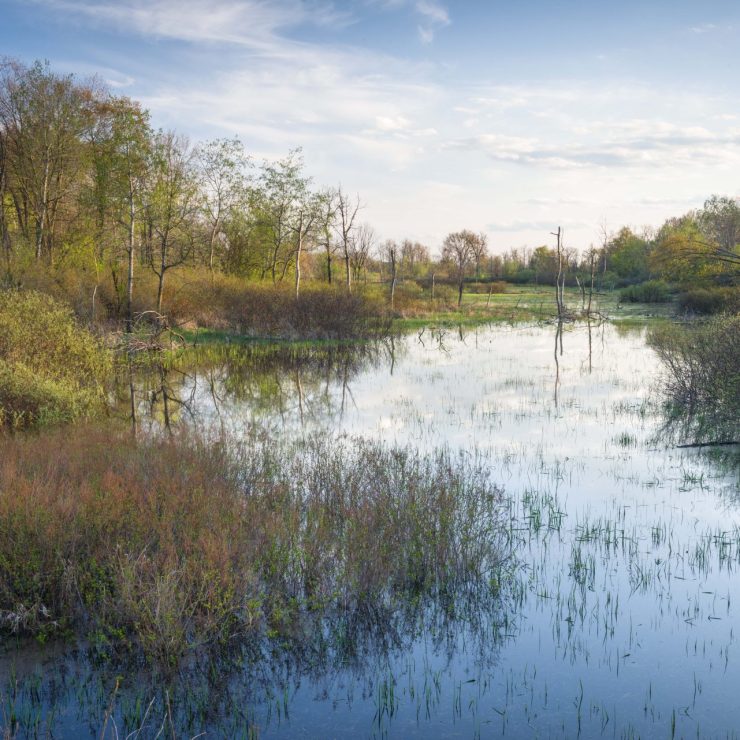By: Andrew Der, CEP
The definition of federally-regulated Waters of the United States (WUS), or “clean water rule”, is less about clean (or dirty) water and more about simply where the upper limit of regulated water is, or is not. Everyone clamors for predictability and uniform definitions of WUS per the Clean Water Act (CWA), but why do they change? If they need fixing, does that mean they were broken?
This last year – especially in fall and winter – have exhibited the most fits and starts in criteria affecting WUS limits on a site level in long time. This discussion affects our projects now and next year. For years, the U.S. Army Corps of Engineers (COE) and the Environmental Protection Agency (EPA) struggled to determine the limits of WUS and gradually less by executive branch rule-making over the last three administrations, but rather more by a combination of federal district and Supreme Court of the U.S. (SCOTUS) rulings.
The most current debate known as Sacketts vs. EPA, and argued in October 2022 to SCOTUS, can provide an opportunity for potential further clarity in CWA COE Section 404 permitting – as well as corresponding state waters and wetlands permitting processes utilizing such determinations. Meanwhile, independent of this, the EPA and the COE in December 2022 provided a media release announcing new (actually similar to the original) proposed Rules which may or may not be congruent with the pending Sackett ruling – unless they wait.
Background
Determining the extent of federal jurisdiction over WUS, which includes wetlands, on the ground level has been challenging to achieve project compliance with both the federal and state permitting processes. Before the first round of 2015 administration rules, the COE historically made practicable determinations of WUS limits based on policy, the ordinary high water mark (OHW), a generic 1986 waters definition, and a 1987 wetland delineation manual (with regional supplements).
Meanwhile to add to the shuffle, for the first time regarding non-wetland WUS, the COE also in December 2022 issued a public notice for Notice of Availability of the Interim Draft of the National Ordinary High Water Mark Field Delineation Manual for Rivers and Streams which could supplement the older wetland manual.
SCOTUS previously considered the issue of defining WUS limits on numerous significant past occasions, bust most notably in the 2006 “Rapanos” ruling which intended to establish limits based more on hydrological connection. And prior to the Rapanos ruling, the 2001 “SWAANC” ruling determined that federal jurisdiction cannot extend to isolated waters, including wetlands.
Since these rulings, the executive branch, via EPA and COE, issued initial guidance and rules resulting in extensive deliberation. The subsequent 2015 rules adopted and expanded SCOTUS’ “significant nexus” test that considers nearby WUS features more in the framework of ecological relationships, if not contiguous or adjacent, but could be potentially incongruent with Rapanos and SWAANC, whereas the 2020 rules largely applied the hydrological connection requirement.
Separately and concurrently, a myriad of lawsuits resulted in some federal courts overturning previous versions of the rules in 24 states in 2018, rendering potentially different definitions in different states. And in an unprecedented move, the executive branch’s current rules were subsequently withdrawn this last year, and the COE and EPA declared current rules to reflect the original ones prior to any changes. These are now proposed to be formalized in the aforementioned December 22 EPA/COE media release.
While new EPA and COE rulemaking may be underway again, SCOTUS will independently render a decision on the Sackett case in 2023. So, here we are.
The Sackett case
An Idaho couple, the Sacketts were unable to build a home on land they own near an Idaho lake due to the COE asserting that their lot contains wetlands that qualify as jurisdictional WUS regulated under the CWA utilizing the significant nexus test – not necessarily carried forward in rule making. The wetlands on their property lack a surface water connection which otherwise might not be expected to be federally regulated by some entities since the property is separated from the lake by a road and buildings.
During their October session, SCOTUS reviewed arguments as to whether there was the proper test for determining if the Sackett wetlands are jurisdictional WUS. The Sacketts’ request to reject the significant nexus test was supported by 29 amicus briefs, regulated potential permittees, some members of Congress, and other stakeholders that opined that the current criteria violates federalism principles undermining the states’ primary responsibilities in addressing land and water protections.
Since EPA and the COE are moving forward with another new set of WUS rules (similar to the original ones) which may or may not be compatible with the upcoming SCOTUS 2023 ruling, a popular opinion of both proponents and opponents is to wait until this SCOTUS outcome first, which makes sense.
Check back later this week to find out the connection between these rules and the projects we do here in Maryland.
